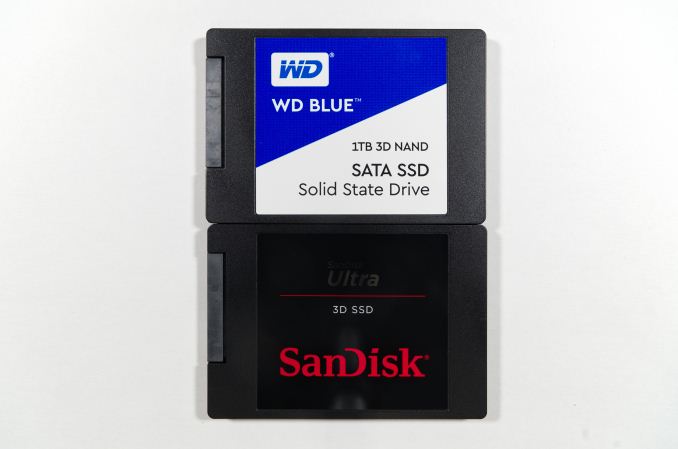One Design, Two Products: The SanDisk Ultra 3D (1TB) and WD Blue 3D (1TB) SSD Reviews, with BiCS 3D NAND
by Billy Tallis on September 14, 2017 9:00 AM ESTConclusion
Compared to last year's WD Blue that used planar TLC NAND flash, the new WD Blue 3D NAND and SanDisk Ultra 3D perform much better on tests where the older drive was weakest. At lower queue depths where the bandwidth of the SATA link was not a bottleneck, the new SSDs delivered significantly better random read and write performance than their predecessors. But the SATA bus has limited how much of a peak improvement 3D NAND could make for the raw performance of Western Digital's SSDs.
Compared to the competing drives on the market today, the new WD Blue 3D NAND and SanDisk Ultra 3D have the performance that is expected of a mainstream SATA SSD. On most real-world workloads, there's no noticeable performance difference between the Ultra 3D and the Samsung 850 EVO. The Ultra 3D also handles being full better than most TLC drives, and does not show the spike in latency that several drives like the Crucial MX300 exhibit. Overall, it is clear that SanDisk is still very good at managing TLC flash and implementing SLC caching in a way that has almost no downsides.
The switch to 3D NAND also brings substantial power savings to the WD Blue 3D NAND and SanDisk Ultra 3D. Idle power is unchanged from the previous generation of drives, but power draw under load is much lower.
| 240-275GB | 480-525GB | 960-1050GB | 2TB | |
| SanDisk Ultra 3D | $89.99 (36¢/GB) | $149.99 (30¢/GB) | $284.99 (29¢/GB) | $549.99 (28¢/GB) |
| WD Blue 3D NAND | $94.99 (38¢/GB) | $164.99 (33¢/GB) | $309.99 (31¢/GB) | $619.99 (31¢/GB) |
| Crucial BX300 | $89.99 (38¢/GB) | $149.99 (31¢/GB) | ||
| Crucial MX300 | $92.99 (34¢/GB) | $149.99 (29¢/GB) | $284.47 (27¢/GB) | $544.62 (27¢/GB) |
| ADATA SU800 | $91.99 (36¢/GB) | $154.99 (30¢/GB) | $269.99 (27¢/GB) | |
| Intel SSD 545s | $99.99 (39¢/GB) | $209.00 (41¢/GB) | ||
| Samsung 850 PRO | $104.99 (41¢/GB) | $209.09 (41¢/GB) | $406.00 (40¢/GB) | $859.99 (42¢/GB) |
| Samsung 850 EVO | $89.99 (36¢/GB) | $147.99 (30¢/GB) | $327.00 (33¢/GB) | $697.99 (35¢/GB) |
Current pricing for the Western Digital SSDs is a bit odd. The WD Blue 3D NAND is more expensive than the SanDisk Ultra 3D by several cents per GB despite the two products being the same under the sticker. The only reason to go with the WD Blue 3D NAND at the moment is for the M.2 version, since the SanDisk Ultra 3D is only available in the 2.5" form factor.
The SanDisk Ultra 3D is priced in between the Crucial MX300 and the Samsung 850 EVO. This matches their relative performance. The performance advantage of the 850 EVO is quite small for most real-world workloads, so its premium mostly buys you a longer warranty and the proven maturity of a product that has been on the market for a long time. If your workload is heavy enough for the difference between the 850 EVO and the Ultra 3D to matter, you should probably be shopping for a NVMe SSD instead of SATA. Meanwhile, the SanDisk Ultra 3D offers higher write endurance ratings and lower power consumption for a slightly lower price. The Ultra 3D makes more sense for most consumers.
Between the SanDisk Ultra 3D and the Crucial MX300, the Ultra 3D should be preferred for heavier workloads. The MX300 will get you an extra 25 or 50GB for the same price, but if you fill up the drive enough for that slightly higher capacity to come into play, the Ultra 3D will perform better. The MX300 still has the advantage in power efficiency and is the better pick for mobile use.
With a good balance of price, performance and power efficiency, the SanDisk Ultra 3D is an easy recommendation.













52 Comments
View All Comments
TheinsanegamerN - Sunday, September 17, 2017 - link
Talk about mountains and molehills.the "performance bottlenecks" of SATA III are only of concern to .01% of buyers. For most tasks, your network interface will be the bottleneck. And when sata IS the bottleneck, the difference between PCIE and SATA are minimal at best.
As for price, I agree that prices are high, but I also know that, having built multiple SSD machines, you are overblowing the issue. 512GB drives can be had for $100 on sale, and that is more storage then 90% of users need.
A drive capable of 500MB/s speeds is hardly low performance.
Magichands8 - Sunday, September 17, 2017 - link
Actually SATA bottlenecks should be of concern for anyone who has to wait for their data to be moved, recovered or otherwise accessed. Which can easily happen if anyone transfers anything on the order of a few gigabytes. It's especially concerning when those bottlenecks are imposed by borderline obsolete technology which is absolutely, completely unnecessary. And the response as to why always seems to be "just because" as if in defense of tech companies dragging their asses. One of the reasons why SSDs were adopted as slowly as they were is because most users weren't even aware of the benefits. For people just checking their Facebook and reading e-mails why even care about SATA III? Just stick with SATA I. Or better yet just ignore SSDs all together and stick with spinning rust. Or hell just use a 15 year old computer. Or by a $200 smart phone and bypass computers all together. More and more it's the case that a smartphone is 'good enough' for most people such that more and more of those of us with actual computers are going to run into the limitations of SATA III. There's just no excuse. I'm aware of the better technology which is one of the reasons why I ignore every SSD release like these here with specs no different than any other SSD. Like I said, if someone is in desperate need of a replacement drive it makes some sense but by and large these releases are pointless. Companies SHOULD have an interest in giving us a reason to upgrade, a reason to buy their products.Slaveguy - Thursday, September 14, 2017 - link
You're crippled by your twisted little kid leg, slaveMajGenRelativity - Thursday, September 14, 2017 - link
What?MrSpadge - Thursday, September 14, 2017 - link
What's a "wrong" form factor, then?Bullwinkle J Moose - Thursday, September 14, 2017 - link
" the SanDisk Ultra 3D is a long-overdue replacement for the Ultra II. Both of the new products use the same technology under the hood; they differ primarily in the stickers on the outside of the drive and the retail packaging it arrives in. "-----------------------------------------------------------------------------------------------------------------------------------
Yup, those new stickers are long overdue!
MajGenRelativity - Thursday, September 14, 2017 - link
The comment on the same tech is in comparison to the WD Blue 3D. The Ultra 3D is clearly different from the Ultra 2kmmatney - Thursday, September 14, 2017 - link
I bought my 1TB Ultra II 3 years ago for $219 - still running great. What is long overdue is lower pricing.ddhelmet - Thursday, September 14, 2017 - link
Why buy this over 850 EVO for 250 and 500 GB? They're both the same price.MajGenRelativity - Thursday, September 14, 2017 - link
Higher endurance and lower power consumption are the advantages the article mentions.